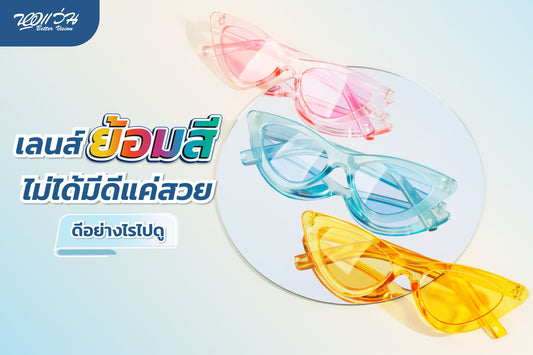Fighting the Thai sun can be difficult for people who wear prescription glasses. When choosing glasses, you may have seen lenses in a variety of colors, such as green, brown, blue, and pink. Have you ever wondered if these tinted lenses really filter light, or are they just for fashion? What are the differences between the colors, and how do you choose the right one? Today, Better Vision has the answers.
What are tinted lenses?
Tinted lenses are prescription lenses that are coated with a tint to help reduce the glare of light, improve vision efficiency, increase color contrast, and make it more comfortable for the wearer to see. Tinted lenses allow people who wear prescription glasses to have built-in sunglasses. Some colors are also suitable for people with certain eye conditions or color vision deficiencies.
The benefits of tinted lenses
Tinted lenses offer a number of benefits, including:
- Reduced glare: Tinted lenses help to reduce the glare of light, which can make it easier to see in bright conditions. This can be especially helpful for people who drive or work outdoors.
- Improved vision efficiency: Tinted lenses can help to improve vision efficiency by increasing contrast and making it easier to focus. This can be helpful for people with mild vision problems.
- Increased color contrast: Tinted lenses can help to increase color contrast, which can make it easier to see objects and details. This can be helpful for people who are color blind or have difficulty seeing in low-light conditions.
- Increased comfort: Tinted lenses can help to reduce eye strain and fatigue by blocking out harmful blue light.
How to choose tinted lenses
When choosing tinted lenses, there are a few factors to consider, including:
- Color: The color of the tint will affect the amount of light that is blocked. Darker colors will block more light, while lighter colors will block less light.
- Tint intensity: The tint intensity will also affect the amount of light that is blocked. Higher tint intensities will block more light, while lower tint intensities will block less light.
- Usage: The type of tint you choose will depend on how you will be using your glasses. For example, if you will be using your glasses outdoors, you will need a tint that blocks more light.
Here are some general recommendations for choosing tinted lenses:
- For everyday use: A light tint (25%-50%) is a good choice for everyday use. This will provide enough protection from glare without making it too difficult to see in low-light conditions.
- For driving: A medium tint (50%-75%) is a good choice for driving. This will provide enough protection from glare without making it too difficult to see at night.
- For outdoor activities: A dark tint (75%-90%) is a good choice for outdoor activities, such as hiking or fishing. This will provide maximum protection from glare and harmful blue light.
It is always a good idea to talk to an eye care professional before choosing tinted lenses. They can help you to choose the right tint and intensity for your individual needs.





